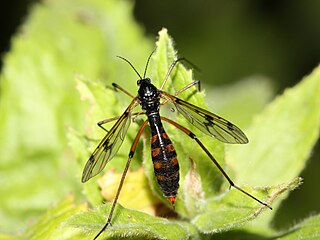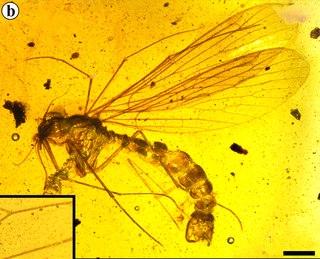
The Cupedidae are a small family of beetles, notable for the square pattern of "windows" on their elytra, which give the family their common name of reticulated beetles.

Bittacidae is a family of scorpionflies commonly called hangingflies or hanging scorpionflies.

The Ptychopteridae, phantom crane flies, are a small family of nematocerous Diptera. Superficially similar in appearance to other "tipuloid" families, they lack the ocelli of the Trichoceridae, the five-branched radial vein of the Tanyderidae, and the two anal veins that reach the wing margins of the Tipulidae. They are usually allied with the Tanyderidae based on similarities of the mesonotal suture, this group being called the Ptychopteromorpha.

Anaxyelidae is a family of incense cedar wood wasps in the order Hymenoptera. It contains only one living genus, Syntexis, which has only a single species, native to Western North America. Fossils of the family extend back to the Middle Jurassic, belonging to over a dozen extinct genera, with a particularly high diversity during the Early Cretaceous. Syntexis lay eggs in the sapwood of conifers, preferring recently burnt wood.

Osmylidae are a small family of winged insects of the net-winged insect order Neuroptera. The osmylids, also called lance lacewings, stream lacewings or giant lacewings, are found all over the world. There are around 225 extant species.

Pelecinidae is a family of parasitic wasps in the Proctotrupoidea. It contains only one living genus, Pelecinus, with three species known from the Americas. The earliest fossil species are known from the Jurassic, and the group was highly diverse during the Cretaceous. Members of Pelecinus are parasitic on larval beetles, flies, green lacewings, and sawflies.

Nemestrinidae, or tangle-veined flies is a family of flies in the superfamily Nemestrinoidea, closely related to Acroceridae. The family is small but distributed worldwide, with about 300 species in 34 genera. Larvae are endoparasitoids of either grasshoppers (Trichopsideinae) or scarab beetles (Hirmoneurinae). Some are considered important in the control of grasshopper populations. Adults are often observed on flowers.

The Berothidae are a family of winged insects of the order Neuroptera. They are known commonly as the beaded lacewings. The family was first named by Anton Handlirsch in 1906.

Ithonidae, commonly called moth lacewings and giant lacewings, is a small family of winged insects of the insect order Neuroptera. The family contains a total of ten living genera, and over a dozen extinct genera described from fossils. The modern Ithonids have a notably disjunct distribution, while the extinct genera had a more global range. The family is considered one of the most primitive living neuropteran families. The family has been expanded twice, first to include the genus Rapisma, formerly placed in the monotypic family Rapismatidae, and then in 2010 to include the genera that had been placed into the family Polystoechotidae. Both Rapismatidae and Polystoechotidae have been shown to nest into Ithonidae sensu lato. The larvae of ithonids are grub-like, subterranean and likely phytophagous.

Pseudopolycentropodidae is an extinct family of scorpionflies known from the Mesozoic. Fossils are known from the Middle Triassic (Anisian) to the early Late Cretaceous (Cenomanian). It is part of Mesopsychoidea, a group of scorpionflies with siphonate proboscis. They are suggested to have been nectarivores, feeding off the liquid pollination drops and acting as pollinators for now extinct insect pollinated gymnosperms such as Bennettitales.
Blattulidae is an extinct family of cockroaches known from the Triassic to the Late Cretaceous. Their distinguishing characteristics include "forewing has long Sc, regular venation with distinct intercalaries and hindwing has simple CuP, branched A1."
Mesoblattinidae is an extinct family of cockroaches known from the Mesozoic. It was formerly considered a wastebasket taxon for Mesozoic cockroaches, but the family has subsequently been better defined, with many taxa transferred to Caloblattinidae. It is considered to have close affinities with Blattidae and Ectobiidae, as well as possibly Blaberidae.
Liberiblattinidae is an extinct family of cockroaches known from the Jurassic to Cretaceous. Some taxa, like Cryptoblatta and Hydrokhoohydra, are suggested to be semiaquatic. Spongistoma is suggested to be a nectarivore due to its unique sucking/sponging "proboscis" mouthparts.
Rhagionemestriidae is an extinct family of brachyceran flies known from the Jurassic and Cretaceous periods. It was first named as a subfamily of the Nemestrinidae by Ussatchov (1968), and was raised to full family status by Nagatomi and Yang (1998). They are considered to be closely related to the family Acroceridae. Similar to Acroceridae, members of the family possess a large hemispherical head, with eyes covering nearly all of the area.

Archisargidae is an extinct family of brachyceran flies known from the Jurassic and Cretaceous periods. It is part of the extinct superfamily Archisargoidea. Most members of the family are known from the Callovian-Oxfordian Daohugou biota of Inner Mongolia, China, and the equivalently aged Karabastau Formation of Kazakhstan. The family has been found to be paraphyletic with respect to Eremochaetidae in a cladistic analysis.
Praeaulacidae is an extinct family of Mesozoic parasitic wasps in the suborder Evanioidea. It among the earliest known families of the group and is characterised by more complete wing venation in comparison to other members of the suborder. It has been found that Othniodellithidae is nested within Praeaulacidae via cladistic analysis.
Mesochrysopidae is an extinct family of lacewings known from the Jurassic and Cretaceous periods. They are considered to be closely related to green lacewings of the family Chrysopidae. The family are also alternatively considered a paraphyletic grade leading up to crown Chrysopidae.
Lophioneurida is an extinct order of Thysanoptera, dating from the Carboniferous to the Cretaceous. It is likely paraphyletic, with modern thrips having evolved from members of the group.

Orthophlebiidae is an extinct family of scorpionflies known from the Triassic to Cretaceous, belonging to the superfamily Panorpoidea. The family is poorly defined and is probably paraphyletic, representing many primitive members of Panorpoidea with most species only known from isolated wings, and has such been considered a wastebasket taxon.
Archizelmiridae is an extinct family of flies, known from the Jurassic and Cretaceous periods. It belongs to the Sciaroidea, and has suggested to have a close relationship with Sciaridae.













